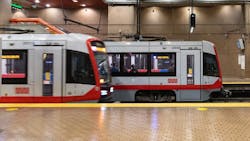California State Transportation Agency awards nearly $800 million for transit and intercity rail projects
Nearly $800 million was awarded by the California State Transportation Agency to 23 projects statewide to expand transit and intercity rail service and reduce greenhouse gas emissions.
The fifth cycle of Transit and Intercity Rail Capital Program (TIRCP) grants kicks off a period of historic investment to improve and expand public transportation throughout California while positioning the state to compete for new federal funding through the Infrastructure Investment and Jobs Act. In addition to the $796.1 million awarded, the recently enacted 2022-23 state budget includes $7.65 billion in TIRCP funding from the General Fund over the next three years.
“Under Governor Gavin Newsom’s leadership, California is making historic investments in transit and intercity rail, and the transformative projects receiving funding today are leading the way to a cleaner, safer, more connected and more equitable transportation system,” said California State Transportation Agency Secretary Toks Omishakin. “I congratulate all the TIRCP grant recipients as we work together to rapidly cut pollution from the transportation sector with faster, more frequent, more affordable and more reliable transit service that increases ridership and reduces our dependence on driving.”
With a total budget of nearly $2 billion consisting of federal, state and local funding, the 23 projects will directly benefit disadvantaged communities and reduce greenhouse gas emissions by an estimated 4.3 million metric tons – the equivalent of taking more than 930,000 gas-powered cars off the road.
Projects receiving funding come from all regions of the state – from Humboldt and Sonoma Counties in the north to Riverside and San Diego Counties in the south – and will result in the purchase of 393 zero-emission buses, 51 zero-emission shuttles or microtransit vehicles, eight new light-rail vehicles and two zero-emission ferries.
Representative projects statewide include:
- More than $116 million for critical transit corridor improvements for San Francisco Muni rail and bus services.
- A major investment in 261 zero-emission buses and NextGen corridor improvements for Los Angeles Metro, totaling more than $177 million.
- More than $60 million in transit-oriented development improvements at East Bay BART stations and in Humboldt County to increase transit ridership and prepare for construction of affordable housing at the transit hubs.
- New and expanded bus services between Humboldt and Mendocino Counties, in Tulare and Kings Counties, between Torrance and Downtown Los Angeles, in the Bay Area’s Interstate 680 Corridor and in Monterey County.
- New and expanded rail service from the Bay Area and Sacramento to Turlock on the Altamont Corridor Express, as well as on the Metrolink Perris Valley line in Riverside County.
A complete list of this year’s recipients can be found online.
Since 2015, TIRCP has provided more than $6.6 billion in funding to nearly 100 projects. TIRCP funding is provided through Senate Bill (SB) 1, the Road Repair and Accountability Act of 2017 and from the Cap-and-Trade program proceeds. Funding for this award cycle was higher than originally estimated due to increased Cap-and-Trade auction proceeds over the past year as well as strong Transportation Improvement Fee revenue.
This is the first TIRCP award cycle to incorporate the Climate Action Plan for Transportation Infrastructure (CAPTI) into its guidelines. Finalized by the California State Transportation Agency last summer, CAPTI details how the state recommends investing billions of discretionary transportation dollars annually to aggressively combat and adapt to climate change while supporting public health, safety and equity.
TIRCP is part of California Climate Investments, a statewide program that puts billions of Cap-and-Trade dollars to work reducing greenhouse gas emissions, strengthening the economy and improving public health and the environment – particularly in disadvantaged communities. The Cap-and-Trade program also creates a financial incentive for industries to invest in clean technologies and develop innovative ways to reduce pollution.
California Climate Investments projects include affordable housing, renewable energy, public transportation, zero-emission vehicles, environmental restoration, more sustainable agriculture, recycling and much more.
